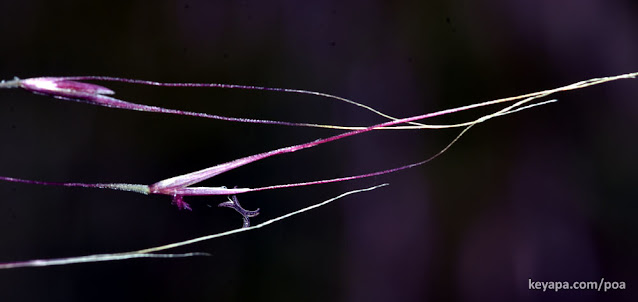 |
| Gorgeous specimens of Muhlenbergia sericea along the sides of the trail |
There is no doubt that species in the genus Muhlenbergia are some of the most beautiful grasses out there, and I mostly encountered them as ornamental grasses in the Northeast USA. But they exist in plentiful varieties as native plants in Florida, a fact that astonished me when I first encountered them in Jacksonville's Atlantic Beach.
This group of grasses are also a prominent fixture in the Nature Conservancy's Disney Preserve in Florida, and when I visited the place to hike a couple days back, they were garbed in masses of absolutely gorgeous pinkish blooms.
 |
| Juvenile alligator hiding under the beautiful M. sericea |
They also seemed to provide an unusual service to the other inhabitants of the park.
Under one large specimen, a juvenile alligator had parked itself under the heavy shade (see image above), perhaps seeking protection from the gawking passersby and other hikers around it. The combination of the airy pink blooms and the primeval looking reptile was striking.
 |
| Beautiful inflorescence of M. sericea |
 |
| Spikelets of M. sericea |
 |
| Two spikelets of M. sericea, each with with two very long awns. One spikelet is showing purple anthers and the filament, as well as the fuzzy stigma. |
6 comments:
So good to find your blog, there at Hollis'. I maybe keepr of wild places but my son always the keeper of grasses. I will read this later today, will have to go out now. Excited to read what you write about Muhlenbergia, i love little muhly, i have to look up her proper name.
Mat Muhly is the one i love around where i live. (Muhlenbergia richardsonii) So Yukon and Florida at least do have genera in common.
Welcome! I am always happy to meet other students and caretakers of members of the Poaceae. And I would be glad to meet your son as well.
Thank you! I will look it up. And given the success of grasses in spreading around the world, I'm pretty sure the two areas share a lot more genera. Panicum perhaps, or cold season grasses like Hordeum, Poa and Festuca.
I looked up that species and it seems it not only exists in the Yukon, but is found all the way south to Mexico and along the western USA. A very successful species indeed!
Yes we do have Hordeum Poa and Festuca :). It is just when i look at the overal picture of plant species, it always seems that in North America, Florida and Yukon seem most different, quite obvious i guess as we are so far apart.
Post a Comment